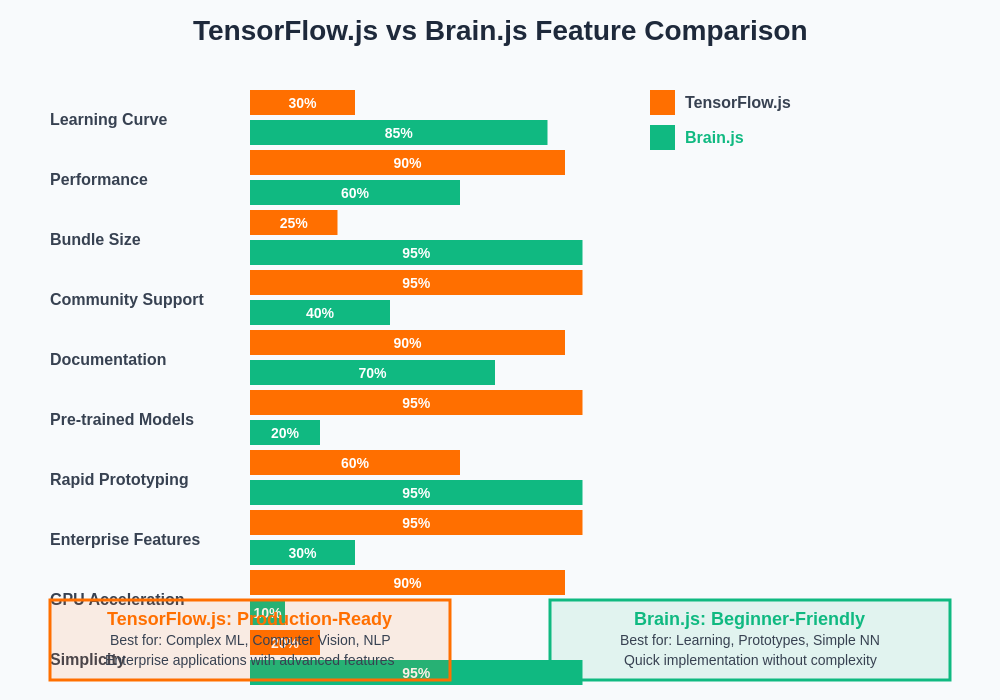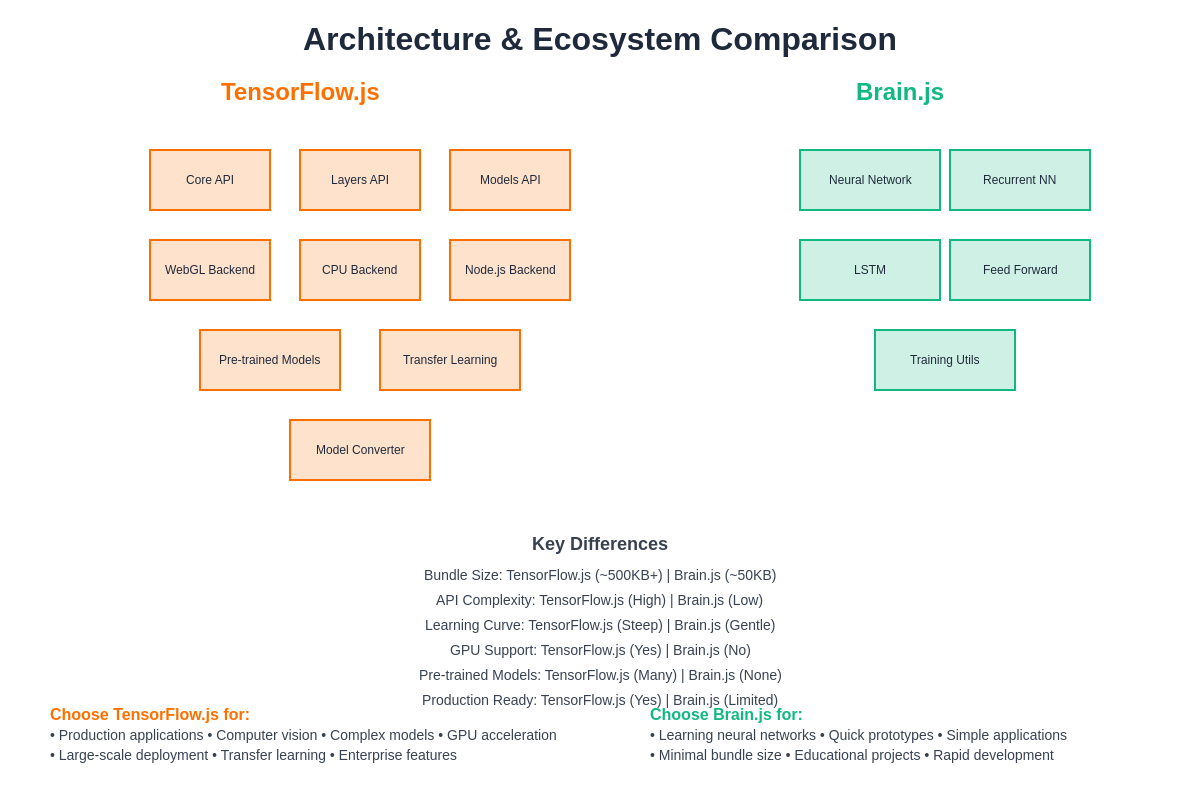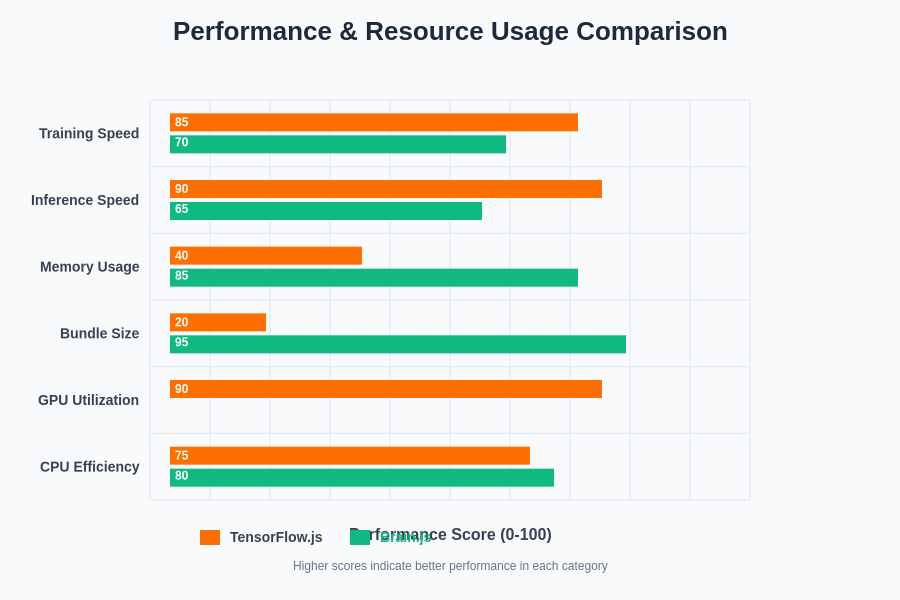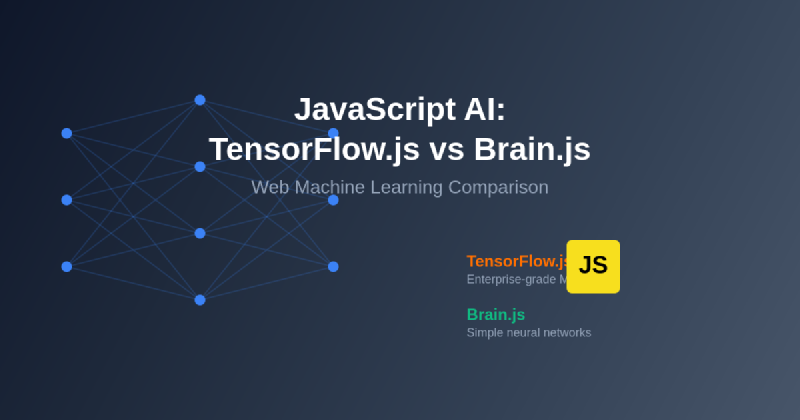The intersection of JavaScript and artificial intelligence has created unprecedented opportunities for developers to implement sophisticated machine learning capabilities directly within web browsers and Node.js environments. Two prominent libraries have emerged as leading solutions for JavaScript-based machine learning: TensorFlow.js, Google’s comprehensive machine learning platform adapted for JavaScript, and Brain.js, a lightweight neural network library designed specifically for JavaScript developers. Understanding the strengths, limitations, and optimal use cases for each framework is essential for making informed decisions about implementing AI functionality in modern web applications.
Explore the latest AI development trends to stay informed about cutting-edge techniques and emerging patterns in web-based machine learning implementations. The choice between TensorFlow.js and Brain.js represents more than a simple library selection; it fundamentally shapes the architecture, performance characteristics, and scalability potential of your machine learning implementations in JavaScript environments.
TensorFlow.js: Enterprise-Grade Machine Learning
TensorFlow.js represents Google’s ambitious effort to democratize machine learning by bringing the full power of TensorFlow to JavaScript environments. This comprehensive framework provides extensive capabilities for building, training, and deploying machine learning models directly in web browsers and Node.js applications. The library’s architecture mirrors the robust functionality of its Python counterpart while maintaining the accessibility and flexibility that JavaScript developers expect from modern web technologies.
The framework’s strength lies in its comprehensive ecosystem, which includes pre-trained models, extensive documentation, and seamless integration with existing TensorFlow workflows. Developers can leverage models trained in Python TensorFlow environments and deploy them directly to JavaScript applications, creating a unified machine learning pipeline that spans multiple programming languages and deployment environments. This interoperability has made TensorFlow.js particularly attractive for organizations already invested in the TensorFlow ecosystem.
TensorFlow.js excels in handling complex machine learning tasks including computer vision, natural language processing, and reinforcement learning applications. The framework’s support for both high-level APIs and low-level tensor operations provides developers with the flexibility to implement everything from simple linear regression models to sophisticated deep learning architectures. The library’s WebGL backend enables hardware acceleration through GPU computing, delivering performance levels that approach native implementations for many machine learning tasks.

The comprehensive feature comparison reveals distinct strengths and trade-offs between the two frameworks, with TensorFlow.js dominating in enterprise-level capabilities while Brain.js excels in simplicity and ease of implementation.
Brain.js: Simplicity-Focused Neural Networks
Brain.js takes a fundamentally different approach to JavaScript machine learning by prioritizing simplicity, ease of use, and rapid prototyping over comprehensive functionality. This lightweight library focuses specifically on neural network implementations, providing an intuitive API that enables developers to quickly implement and experiment with various neural network architectures without requiring extensive machine learning expertise or complex configuration procedures.
The library’s design philosophy centers around removing barriers to entry for JavaScript developers who want to incorporate neural network functionality into their applications. Brain.js provides straightforward APIs for common neural network patterns including feedforward networks, recurrent networks, and long short-term memory networks. This focused approach allows developers to implement functional neural networks with minimal code and configuration, making it particularly suitable for prototyping and educational applications.
Enhance your AI development with Claude’s advanced reasoning for complex problem-solving and comprehensive code generation across multiple machine learning frameworks. Brain.js particularly shines in scenarios where simplicity and rapid development are prioritized over advanced functionality, making it an excellent choice for developers who need to quickly add intelligent behavior to web applications without deep machine learning expertise.
Performance and Scalability Considerations
The performance characteristics of TensorFlow.js and Brain.js differ significantly due to their architectural approaches and optimization strategies. TensorFlow.js leverages sophisticated optimization techniques including operator fusion, memory management, and hardware acceleration through WebGL and WebAssembly backends. These optimizations enable TensorFlow.js to handle large-scale machine learning tasks with performance levels suitable for production applications requiring real-time inference and complex model architectures.
TensorFlow.js benefits from Google’s extensive research and development investment in machine learning optimization, resulting in highly efficient implementations of common operations and algorithms. The framework’s ability to utilize GPU acceleration through WebGL provides substantial performance improvements for computationally intensive tasks such as image processing, computer vision, and deep learning inference. Additionally, the framework’s support for model quantization and pruning enables deployment of optimized models that maintain accuracy while reducing computational requirements and memory footprint.
Brain.js prioritizes simplicity over performance optimization, resulting in more straightforward implementations that may not achieve the same performance levels as TensorFlow.js for large-scale applications. However, this trade-off enables faster development cycles and easier debugging for smaller-scale applications where maximum performance is not the primary concern. The library’s lightweight architecture results in smaller bundle sizes and faster initialization times, which can be advantageous for applications where startup performance is critical.

The architectural differences between TensorFlow.js and Brain.js reflect their distinct design philosophies, with TensorFlow.js offering a comprehensive multi-layered ecosystem while Brain.js maintains a focused, streamlined approach to neural network implementation.
Development Experience and Learning Curve
The development experience provided by each framework reflects their different design philosophies and target audiences. TensorFlow.js offers a comprehensive but complex development environment that requires significant learning investment to master effectively. The framework’s extensive API surface, multiple abstraction levels, and sophisticated configuration options provide tremendous flexibility but can overwhelm developers new to machine learning or the TensorFlow ecosystem.
TensorFlow.js documentation and community resources are extensive, reflecting Google’s commitment to supporting the framework’s adoption across diverse use cases and skill levels. The availability of pre-trained models, transfer learning capabilities, and integration with TensorFlow Hub significantly reduces the barrier to implementing sophisticated machine learning functionality. However, effective utilization of these advanced features often requires substantial machine learning knowledge and experience with the broader TensorFlow ecosystem.
Brain.js provides a more approachable development experience with intuitive APIs and minimal configuration requirements. The library’s focus on common neural network patterns enables developers to achieve functional results quickly without extensive machine learning background or framework-specific knowledge. The simplified API design reduces the cognitive overhead associated with implementing neural networks, making it particularly suitable for developers who need to add intelligent behavior to applications without becoming machine learning specialists.
Model Training and Deployment Workflows
The model training and deployment workflows supported by each framework reflect their different architectural approaches and intended use cases. TensorFlow.js provides comprehensive training capabilities that enable developers to build models from scratch using browser-based or Node.js environments. The framework supports various training strategies including supervised learning, unsupervised learning, and reinforcement learning, with sophisticated optimization algorithms and regularization techniques that ensure robust model performance.
TensorFlow.js excels in scenarios requiring transfer learning, where pre-trained models are adapted for specific use cases through additional training on domain-specific data. This approach significantly reduces training time and computational requirements while leveraging the knowledge embedded in models trained on large-scale datasets. The framework’s integration with TensorFlow Serving and TensorFlow Lite enables seamless deployment across various platforms and environments, from web browsers to mobile applications and edge devices.
Brain.js focuses on straightforward training workflows that prioritize ease of use over advanced optimization techniques. The library provides intuitive training APIs that enable developers to quickly experiment with different network architectures and training parameters without extensive configuration. While Brain.js may not offer the advanced training features available in TensorFlow.js, its simplified approach enables rapid prototyping and experimentation for developers who need functional neural networks without complex training procedures.
Leverage Perplexity’s research capabilities for comprehensive analysis and comparison of machine learning frameworks, algorithms, and best practices across different implementation approaches. The deployment workflow for Brain.js models typically involves serializing trained networks and loading them in production environments, with minimal infrastructure requirements compared to more complex TensorFlow.js deployment scenarios.
Use Case Suitability and Application Domains
The optimal choice between TensorFlow.js and Brain.js depends heavily on specific use case requirements, performance expectations, and development constraints. TensorFlow.js is particularly well-suited for applications requiring sophisticated machine learning capabilities, including computer vision tasks such as image classification, object detection, and image segmentation. The framework’s robust support for convolutional neural networks and pre-trained vision models makes it ideal for applications involving visual content analysis and interpretation.
Natural language processing applications also benefit significantly from TensorFlow.js capabilities, particularly when leveraging pre-trained language models and transfer learning techniques. The framework’s support for recurrent neural networks, transformer architectures, and attention mechanisms enables implementation of sophisticated text analysis, sentiment analysis, and language generation capabilities. These advanced NLP features are essential for applications requiring deep understanding of textual content and context-aware responses.
Brain.js excels in scenarios where simplicity and rapid development are prioritized over advanced functionality. The library is particularly suitable for applications requiring basic pattern recognition, simple prediction tasks, or educational implementations where understanding the underlying neural network concepts is important. Brain.js is also well-suited for prototyping scenarios where developers need to quickly validate machine learning approaches before committing to more complex implementations.
Community, Documentation, and Ecosystem Support
The community and ecosystem support available for each framework significantly impacts long-term viability and development productivity. TensorFlow.js benefits from Google’s substantial investment in community building, comprehensive documentation, and extensive educational resources. The framework’s integration with the broader TensorFlow ecosystem provides access to a vast collection of pre-trained models, research papers, and implementation examples that accelerate development and learning processes.
The TensorFlow.js community includes contributions from both Google engineers and independent developers, resulting in a diverse ecosystem of extensions, tools, and educational materials. The framework’s compatibility with TensorFlow Hub enables access to state-of-the-art models across various domains, while the active development community ensures regular updates, bug fixes, and feature enhancements that keep the framework current with machine learning research advances.
Brain.js maintains a smaller but dedicated community focused on simplicity and accessibility in JavaScript machine learning. While the community resources may be less extensive than TensorFlow.js, the focused scope and simplified architecture result in more approachable documentation and learning materials. The library’s emphasis on educational use cases has generated valuable resources for developers learning neural network concepts and JavaScript implementation techniques.
Integration Patterns and Architecture Considerations
The integration of machine learning capabilities into existing JavaScript applications requires careful consideration of architectural patterns and performance implications. TensorFlow.js provides multiple integration approaches, from client-side inference using pre-trained models to server-side training and inference using Node.js environments. The framework’s flexibility enables implementation of various architectural patterns including edge computing, hybrid cloud-client processing, and distributed training scenarios.
TensorFlow.js supports both synchronous and asynchronous operations, enabling efficient integration with existing application architectures without blocking user interfaces or disrupting application responsiveness. The framework’s modular design allows selective import of required functionality, reducing bundle sizes and improving application startup performance. Advanced features such as model serving, caching, and optimization enable sophisticated deployment scenarios that meet enterprise-scale requirements.
Brain.js integration patterns focus on simplicity and minimal architectural complexity, making it straightforward to add neural network functionality to existing applications. The library’s lightweight design and minimal dependencies reduce integration overhead while providing sufficient functionality for common neural network use cases. The straightforward serialization and deserialization of trained models enables easy integration with various deployment scenarios and application architectures.
Future Development and Technology Trends
The ongoing evolution of both TensorFlow.js and Brain.js reflects broader trends in machine learning technology and web development practices. TensorFlow.js continues to benefit from Google’s substantial research and development investment, with regular updates that incorporate cutting-edge machine learning techniques and optimization improvements. The framework’s roadmap includes enhanced performance optimization, expanded pre-trained model availability, and improved integration with emerging web technologies such as WebAssembly and WebGPU.

The performance metrics demonstrate clear trade-offs between the frameworks, with TensorFlow.js excelling in computational efficiency and GPU utilization while Brain.js offers advantages in resource conservation and bundle size optimization.
The growing importance of edge computing and privacy-preserving machine learning has positioned TensorFlow.js advantageously for implementing client-side machine learning capabilities that maintain data privacy while delivering sophisticated AI functionality. The framework’s support for federated learning and differential privacy techniques aligns with evolving regulatory requirements and user expectations regarding data handling and privacy protection.
Brain.js development focuses on maintaining its core philosophy of simplicity while incorporating improvements that enhance performance and usability without compromising ease of use. The library’s emphasis on educational applications and rapid prototyping ensures continued relevance for developers who prioritize learning and experimentation over production-scale deployment requirements.
The convergence of machine learning and web technologies continues to drive innovation in both frameworks, with emerging trends such as progressive web applications, serverless computing, and edge AI creating new opportunities for JavaScript-based machine learning implementations. Understanding these trends and their implications for framework selection enables developers to make informed decisions that align with both current requirements and future technology evolution.
Practical Implementation Guidance
Selecting between TensorFlow.js and Brain.js requires careful evaluation of project requirements, team expertise, and long-term maintenance considerations. Projects requiring sophisticated machine learning capabilities, production-scale performance, or integration with existing TensorFlow workflows should strongly consider TensorFlow.js despite its increased complexity. The framework’s comprehensive feature set and robust optimization capabilities justify the additional learning investment for applications with demanding performance requirements.
Brain.js represents the optimal choice for projects prioritizing rapid development, educational applications, or scenarios where machine learning functionality represents a secondary feature rather than a core requirement. The library’s simplicity and minimal configuration requirements enable quick implementation and experimentation without the overhead associated with more comprehensive frameworks.
Successful implementation of either framework requires consideration of factors beyond pure technical capabilities, including team expertise, maintenance requirements, and integration with existing development workflows. The choice between TensorFlow.js and Brain.js ultimately depends on balancing functionality requirements against development complexity and long-term maintenance considerations.
Disclaimer
This article provides general information about TensorFlow.js and Brain.js for educational and informational purposes only. Framework selection should be based on careful evaluation of specific project requirements, technical constraints, and team capabilities. The effectiveness and suitability of each framework may vary depending on individual use cases, performance requirements, and implementation contexts. Readers should conduct thorough testing and evaluation before making final framework selection decisions for production applications.
